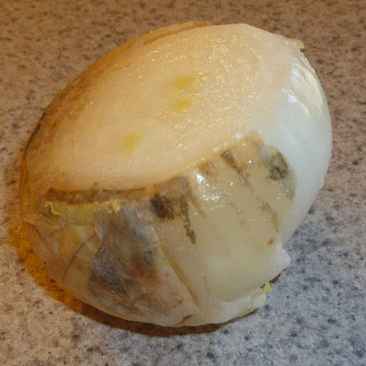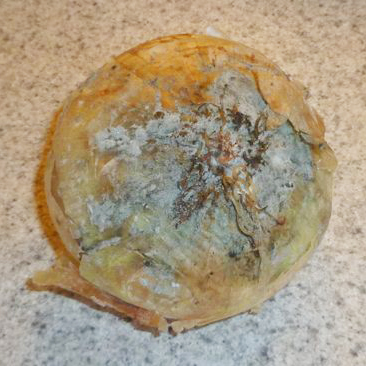Removing Mold
The Moldy Onion
Author: Gene Walshaw, Certified Mold Inspection and Assessment
One morning I craved comfort food and searched the refrigerator for an onion to make the perfect breakfast omelet. The lone onion I found had a thick layer of mold growth, which looked unhealthy, not to mention unappetizing. Knowing onions have layers and most molds have shallow hyphae (roots), I decided to take a chance. The first two layers of the onion were carefully peeled off and wallah…underneath was a perfectly delicious looking, fresh and clean onion. Throwing caution to the wind, I proceeded to slice the onion for sautéing.



Then it occurred to me …. removing mold from an onion for safe consumption could be compared to removing mold from a house for safe breathing. Many mold remediators and mold inspectors in the Knoxville area have the misconception that killing mold by using an antimicrobial or biocide automatically makes an area safe to breathe. As with humans (and pets), most of our mold health issues come from breathing the microscopic spores produced by mold. What some mold remediators and inspectors don’t realize is that dead mold spores cause the same allergenic and health reactions as live mold spores. Treating mold properly can stop it from growing, but does not automatically make the air healthy for you to breathe.
Back to the onion. If I had first sprayed that onion with an antimicrobial or biocide, would it then make sense to leave the mold on and eat it? Of course not! Yet consumers in this area are consistently told that fogging/misting the air or moldy surface with “biocides” will change mold into some inert substance that is safe to breathe. Alchemists have tried to change common metals into gold using chemicals for hundreds of years. It didn’t work for them either. So what’s the solution to removing mold? The answer is relatively simple.
Back again to the onion. Remember, what I did to make it safe to eat? I physically removed the layers of mold-encrusted skin and threw them away.
Here’s how a good mold remediator might typically remove a medium to a large area of visible mold in a building or home… First, they should run a “negative air HEPA filtering device” to prevent contamination into other areas. Second, a HEPA vacuum would remove the loose surface mold. Third, if the mold colony is well established, they might wet scrub the affected area or contents. The EPA states a solution of dishwashing soap and water can be used. Or, environmentally safe biocides can be used to combine cleaning and killing mold. But your sensitivity to the biocide must be known first. Fourth, scrub the mold infected surfaces with a soaked towel, brush, or scrub pad. Fifth, wipe or rinse it all off. Last, if a dishwashing liquid was used to clean, apply a safe biocide rated to kill mold hyphae and spores*.
Amazingly, this makes perfect sense! The mold and its attached spores are now removed instead of just sprayed and left in place. Even God instructed Moses to write in Leviticus 14:39-47 that the mildew infected parts of a house should be taken out (removed) to an unclean area of town.
However, this cleaning and removal process can be labor intensive. Mold remediators companies can’t clean for free and are due extra payment for the additional labor. Which method do you now think is the better and safer way for you? The low-priced filter and spray method? Or the higher priced filter, clean, remove, and disinfect?
It’s time to make another omelet. I wrote today’s blog not as a teach-all for removing mold, but as a short introduction. In my “mold library” are numerous documents that detail the proper steps and additionally accepted protocols for finding, removing mold, and preventing its return. That’s a good lead-in to another blog, perhaps about mold and some other type of food. Bon Appetite!
Author: Gene Walshaw, Certified Mold Inspection and Assessment
“Personalized IAQ Consulting, Investigation, and Sampling”
*This blog is not intended as a do-it-yourself guide to mold removal. Other, more intensive investigation may first be needed by a certified mold inspector to find hidden mold growth and its spores. Other approved methods are available for removing mold. This blog is intended to make you aware that removing mold is not accomplished solely by simply spraying and filtering.
Our Service Area
Best Choice Inspections offers home, commercial, and specialty inspections for the Knoxville, TN Metropolitan Area. Our service area includes Maryville, Oak Ridge, Loudon, Lenoir City, Kingston, Oliver Springs, Clinton, Andersonville, Maynardville, Rutledge, Jefferson City, Sevierville, Pigeon Forge, and Gatlinburg.
We also inspect large homes/estates in Sequoyah Hills, Fourth & Gill, Forest Brook, Bearden, and Old North Knoxville.
